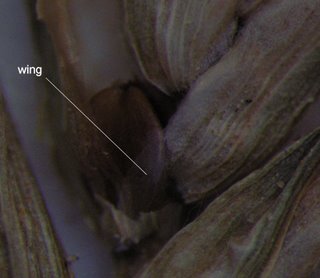Sedge Buster Part 2 Cyperus Lesson 4 - wings
Yikes! I am only into to the b sheets and already I have respelled and respelled again due to all the taxonomic changes since these sheets were last examined. For example, Cyperus brevifolius is now Kyllangia brevifolia. However, I can assure everyone that the specimens have not changed, only their names.
This lesson is about flat sedge wings. Flat sedge wings are usually hyaline (means translucent) little appendages that attach at one end on the proximal (lower) end of a scale and the other end is attached to the rachilla of the spikelet. The rachilla is the little stem that all the florets are attached to. Functionally, one might wish to think of flat sedge wings as hemi-peryginia, for they partially enfold the achene. Not all flat sedges have wings. But some do. So wings are an important key character.
 The wing you see in the photo belongs to Cyperus compressus, another cosmopolitan, annual Cyperus. See the little short fat achene. Short fat achenes are characteristic of this particular flat sedge.
The wing you see in the photo belongs to Cyperus compressus, another cosmopolitan, annual Cyperus. See the little short fat achene. Short fat achenes are characteristic of this particular flat sedge.
This lesson is about flat sedge wings. Flat sedge wings are usually hyaline (means translucent) little appendages that attach at one end on the proximal (lower) end of a scale and the other end is attached to the rachilla of the spikelet. The rachilla is the little stem that all the florets are attached to. Functionally, one might wish to think of flat sedge wings as hemi-peryginia, for they partially enfold the achene. Not all flat sedges have wings. But some do. So wings are an important key character.
 The wing you see in the photo belongs to Cyperus compressus, another cosmopolitan, annual Cyperus. See the little short fat achene. Short fat achenes are characteristic of this particular flat sedge.
The wing you see in the photo belongs to Cyperus compressus, another cosmopolitan, annual Cyperus. See the little short fat achene. Short fat achenes are characteristic of this particular flat sedge.

4 Comments:
This was confusing me for a while peryginia till i thunk on it a bit and voilà! perigynia
you coulds link some of th more obscure term especially the grass and seedge ones to definitions so that those with less than a full head of grass and sedge type terms would get an pains in their brains.
Yep. But they could also do a word search for peryginia and find it defined with lotsa pictures back in the sedge buster carex parts. thanks for reminding me about wings. It took me years to figure out what wings were. You know Godfrey & Wooten, Aquatic & Weltland Plants of SE US. They don't mention wings in their key to the Cyperus. I used to rely on them for the pictures. But then I began to realized that I couldn't get many of the sedges to key out right. Maybe that was just me though.
I found out the same thing, many spellings of peryginia but since it brakes down to peri- (around), gynia- (female) that makes sense.
Since I live hear and travel very little to the east the few cyperus here and west are narrowed donw to just a few species making it much easier to reconize them by sight.
There are around 25 species in Travis County according to Dr. Carr's list. But of these, several are tiny and several more are rare and some of them may no longer be here and some different ones, like C. entrerianus have been found since that list was done. Do you have a copy of that flora?
Post a Comment
<< Home